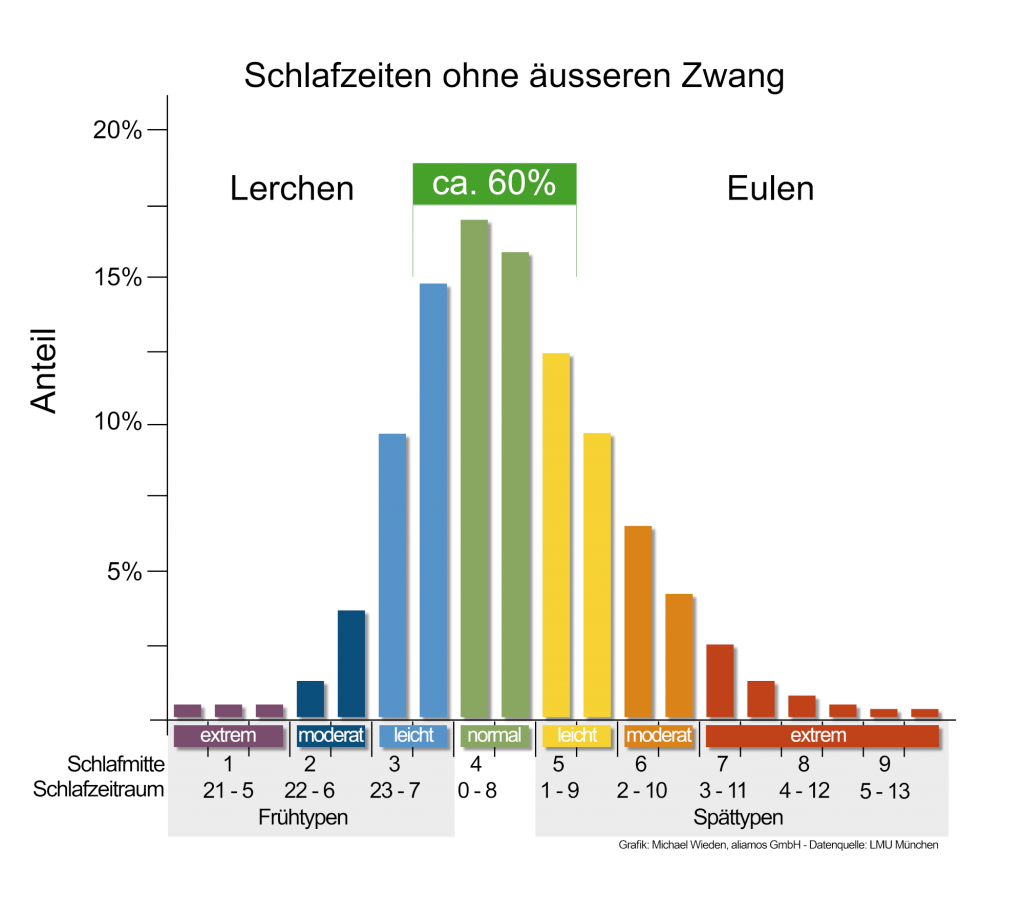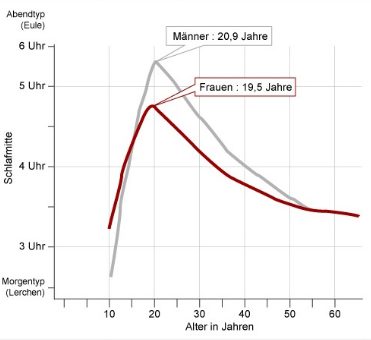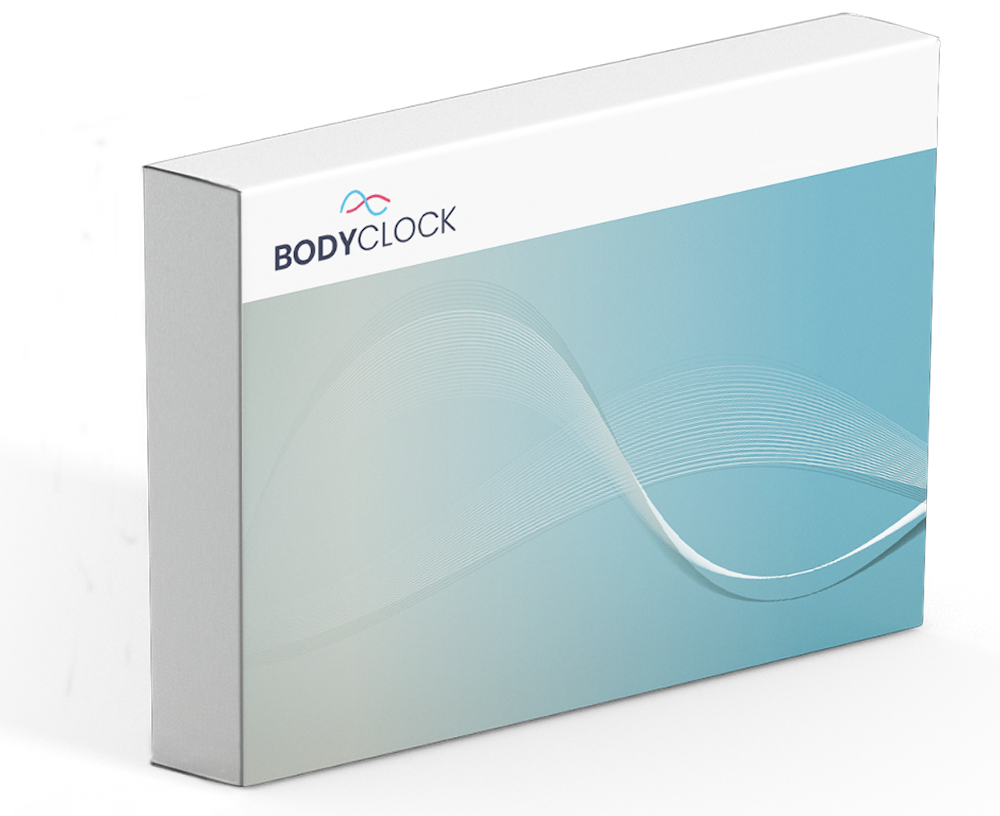What is a chronotype?
“What is a chronotype?” I am often asked this question. Which chronotype we have depends largely on how our internal clock ticks. Everyone can easily observe that we all have a different chronotype. There are people around us who have no problem getting out of bed in the morning without an alarm clock and are immediately productive, but who get tired early in the evening.
On the other hand, there are people who are still productive late at night but have no chance of waking up in the morning without an alarm clock.

Whether in schools, at work or at events … the effects of these different biological rhythms can be seen everywhere. We often notice for ourselves that we always get tired and wake up at similar times, are hungry at certain times and are mentally particularly receptive at other times. However, this is where we can sometimes differ greatly from our fellow human beings. We see this most clearly in the times at which we go to sleep or wake up in the morning. Some are active first thing in the morning, others only really wake up around midday.
Basic information on the chronotype designations
The terms used for chronotypes, such as early or late type, or even normal type, must be treated with caution. The chronotype describes the chronological position in comparison to all persons tested so far. The effects of this can be seen, for example, in the “normal type”. Firstly, in this case “normal” does not mean “healthy” or “non-abnormal”, but represents the largest group of all the people tested. At the same time, we also see that this group goes to bed on average between midnight and 1 a.m. and would wake up between 8 a.m. and 9 a.m. without an alarm clock. However, this sleep-wake behavior alone is often associated with that of a “late type, late sleeper or owl”. However, a real owl goes to bed much later. Thus, an early type is only early compared to all others tested, without “early” per se automatically meaning a specific period of time. For example, the allocation may be different if only one restricted group (e.g. inhabitants of another country, a city or employees of a company) is taken as the basic population.
Incidentally, the term “late riser” is wrong when it comes to chronotypes. Individual sleep needs have nothing to do with chronotype. You can also be a late riser if you are an early riser.
How do I determine the chronotype?
We have answered the question “What is a chronotype”. But how do you determine it? There are basically 3 ways to determine the chronotype.
- Personal observation
- Evaluated questionnaire
- BodyClock RNA test
Personal observation
This appears to be the simplest method at first, but it is also the most error-prone. Anyone who is subject to the daily corset of an externally prescribed time structure has little chance of being able to determine their actual biological rhythm through self-assessment alone. External influences such as the alarm clock, external noise sources or the roller blind are too dominant. This can easily lead to misjudgments. Simply waking up 5 minutes before the alarm clock is wrongly seen as an indication of the chronotype. However, this phenomenon is usually due to conditioning rather than genetic predisposition.
However, if you have the opportunity to go to bed and wake up without an alarm clock or other external stimulus (children, partner, noise, etc.) for at least (!) 3 weeks in a row, you will notice after about 10 days that your sleep-wake rhythm settles into a certain range. Another prerequisite is that you do not drink alcohol, especially in the evening, and that you do not take any medication that affects your sleep. If all this is guaranteed, there is a good chance that the natural rhythm will emerge after about 10 days. In order to find out the chronotype, it is best to note the time at which you fell asleep and woke up over a longer period of time (after the 10 days). Then calculate the center of sleep.
Example: If you sleep from 00:00 to 09:00, the middle of your sleep is at 04:30 in the morning. You can then read off your chronotype from the graphic above.
So leave your alarm clock at home on vacation and don’t give a damn about being the first at the breakfast buffet or on the lounger by the pool.
Evaluated questionnaire
One of the evaluated questionnaires offers a simpler and faster method. If this is available online, you will usually receive a result immediately. However, the prerequisite here is that you answer the questions as objectively and accurately as possible. Even those who are hoping for a certain result might tend to answer the questions subjectively just to get a certain result. One of the best-known questionnaires is the MCTQ (Munich Chronotype Questionnaire) developed under Prof. Till Roenneberg at LMU Munich. Most representations of the distribution of chronotypes that can be found are based on the year-long evaluation of this questionnaire, which was completed by over 25,000 participants. Unfortunately, this can no longer be found online. However, the D-MEQ of IfADo (Leibniz Institute for Employment Research at TU Dortmund University) is still online. You can find it here:
https://www.ifado.de/fragebogen-zum-chronotyp-d-meq/
BodyClock RNA test
In 2017, Prof. Achim Kramer at Charité Berlin presented a scientific RNA test for chronotype determination to the public for the first time. For their study, the researchers first took blood samples from test subjects several times throughout the day and tracked the activity of around 20,000 genes. The researchers then used an adaptive algorithm to isolate twelve genes from these 20,000 genes. They show the so-called DLMO of the test person. The DLMO indicates the time at which the natural release of melatonin begins. Based on this, you can determine which chronotype this corresponds to.
With this method, any subjective disturbance can be ruled out. In my projects, this blood test was also used for the first time on a large scale in companies and clinics.
Since April 2021, an RNA test from the company has also been available for the first time. BodyClock is offered on the basis of hair root samples. This means that anyone can have their chronotype determined without a doctor. After the analysis, there is a comprehensive results report in which tips and advice make it easier to deal with your own chronotype.
More about this test incl. You can order here on the BodyClock website.
The distribution in the population
The distribution of the individual chronotypes within a population is continuous and distributed like a bell curve, with the early and late types at the two ends on the left and right. Put simply, a late type with a mid-sleep time of around 06:00 is only later than an early type with a mid-sleep time of around 02:00. So early or late is just as relative as big or small. It depends on the group you are comparing with. The figure above shows the distribution in the German population based on over 25,000 people who completed the MCTQ (LMU Chronotype Questionnaire). This evaluation also forms the basis for the classification of chronotypes.
Change in the course of life

An early type cannot change into a late type, but our chronotype changes over the course of our lives. While we initially develop very strongly into a late type at the beginning of puberty, a slight but continuous change towards an earlier type begins again from adolescence onwards. Young pupils are particularly affected. Despite contrary biological developments, they still have to contend with extremely early school start times. It has long been known that starting school later would lead to better grades, but pupils still prefer to be bent around the school rather than the school bending around the pupils. In addition to the long-term detrimental effects on health, the potential that is lost is enormous.


